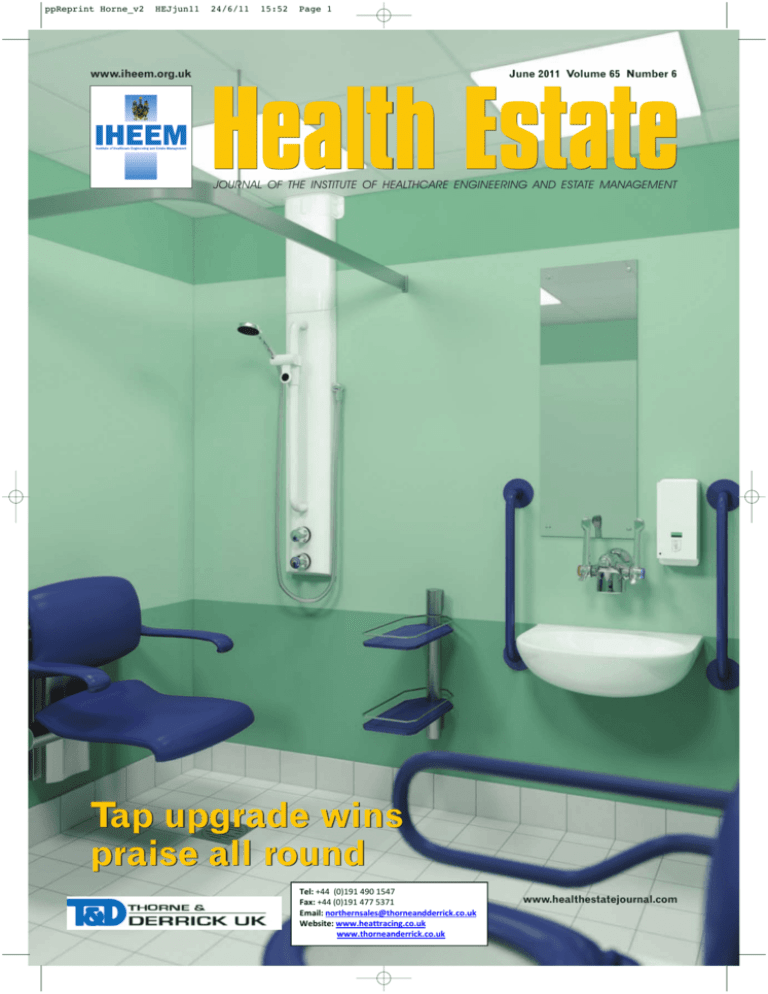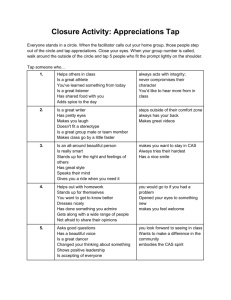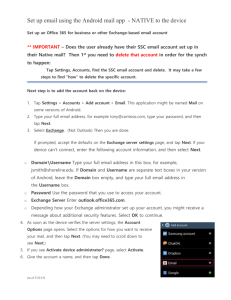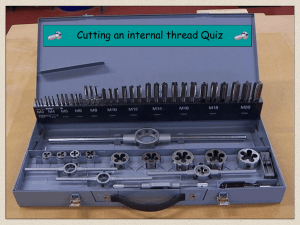Tap Upgrade Wins Praise All Round
advertisement

ppReprint Horne_v2 HEJjun11 24/6/11 15:52 Page 1 www.iheem.org.uk June 2011 Volume 65 Number 6 Health Estate JOURNAL OF THE INSTITUTE OF HEALTHCARE ENGINEERING AND ESTATE MANAGEMENT Tap upgrade wins praise all round Tel: +44 (0)191 490 1547 Fax: +44 (0)191 477 5371 Email: northernsales@thorneandderrick.co.uk Website: www.heattracing.co.uk www.thorneanderrick.co.uk www.healthestatejournal.com ppReprint Horne_v2 HEJjun11 24/6/11 15:52 Page 2 Plumbing systems Tap upgrade wins praise all round Courtesy of NHS Lanarkshire An ongoing upgrading of clinical handwashing facilities at its hospitals by NHS Lanarkshire is seeing the Scottish Health Board replace, in many cases, ageing basins and taps subject to Healthcare Environment Inspectorate (HEI) criticism, with standardised modules comprising a clinical basin, Horne Engineering’s Optitherm thermostatic tap, and soap and towel dispensers, all mounted on a single integrated panel structure. As Horne’s marketing manager, Hannah Berry, explains, one of the many benefits is that the Board’s Estates Department no longer needs a large “arsenal” of spare parts in stock for different fittings. Optitherm taps are now in use, or being installed, not only at the Monklands Hospital (left), but also at the Hairmyres Hospital (centre) in East Kilbride, and at the Wishaw General Hospital (right). N HS Lanarkshire, in Scotland’s central belt, started a programme of rolling refurbishment in August 2010 to replace all clinical handwashing facilities across its estate. The standardised module that it is now using comprises a clinical basin, the Optitherm thermostatic tap from Horne Engineering, and soap and towel dispensers, all mounted on a single integrated panel structure. Prior to this, handwashing facilities within the Board’s hospitals and other healthcare facilities were in dire need of an upgrade, and had been commented upon in a recent Healthcare Environment Inspectorate (HEI) report for Monklands Hospital in Airdrie. An allocation of new funding allowed the problems with the existing estate to be addressed. The Optitherm tap, which comprises a thermostatic mixing valve (TMV), warm water tap, and a dedicated cold water tap combined into a single unit that offers significant benefits relating to installation, operation, and maintenance, was first trialled out at Monklands Hospital, a large district general hospital offering acute services and a 24-hour 2 accident and emergency department which has 535 inpatient beds. Over the course of several months, I spoke with Billy Lindsay, Monklands Hospital’s maintenance manager, and Linda Thomas, infection control nurse, about their decision to standardise on the Optitherm tap at Monklands, and then propose its installation across the entire Trust estate. The initial problem The policy on clinical handwashing basins and taps at Monklands prior to December 2009 had, I discovered, been very informal and, over a number of years, resulted in the use of great variety of basins and lever and spout configurations. A large arsenal of costly spare parts for the numerous Reprinted from Health Estate Journal June 2011 A large arsenal of costly spare parts for the numerous fitting types was required to be held in estates stores fitting types was required to be held in estates stores – wasting valuable space and money. The need to be familiar with a large number of variants also affected the efficiency with which the maintenance team could operate when repairing multiple items. Broken levers from ageing fittings, and underperforming and inaccessible TMVs and swan-neck spouts, which were highlighted in a HEI report as potential reservoirs for infection, were problems that began to mount up and become an increasing battle for the maintenance team to attend to. Billy Lindsay and his team generally try to avoid on-the-ward maintenance where possible, preferring to remove the offending item to the workshop to be repaired. For example, three taps (or associated TMVs) in a four-bed area could be in need of attention, and these would be removed to the workshop for maintenance. The downside is that while the taps or TMVs are being worked on, the whole four-bed area needs to be shut down, causing delays and frustration for staff and patients alike. It was, however, Bill Lindsay explained, not always possible to avoid on-the-ward maintenance. For example, a recent ppReprint Horne_v2 HEJjun11 24/6/11 15:52 Page 3 Plumbing systems identification of Stenotrophomonas Maltophilia bacteria in both the hot and cold water supplies of the intensive therapy unit (ITU) at Monklands Hospital caused severe disruption due to the need for regular water sample collection. Removing wall panels discounted, due to the problems associated with lack of access for maintenance and water sample collection, as well as the difficulties regarding installation. In addition, the regulations regarding the control of Legionella (HTM 04-01, 2007) now suggest that, to minimise mixed water “deadlegs”, TMVs should be connected directly to the outlet or be integral with it, and be the method of flow and temperature control. This regulatory change meant that a thermostatic tap was recommended, and a number of such systems were then available on the market. To access the water supply, sampling points immediately upstream of the TMV have historically required the wall panel to be removed, which presented an infection risk to patients in the immediate vicinity. It has therefore proven necessary to put in place costly measures to reduce the Discounted due to size/ infection risk before breaching cleaning difficulties the wall. Following sample collection, the wall panel has had A number of thermostatic tap to be put back in place and the designs were discounted due to area made clinically clean again. their small size and difficulties This has proved an extremely regarding their cleaning. The taps costly process – in terms of have acute angles and hard to maintenance time, use of reach places – “they are full of specialised equipment, downtime nooks and crannies” that are of the handwash stations, and difficult to clean effectively. The The Optitherm was considered very easy to clean due disruption to healthcare workflow, surface of the taps’ hot inlet was to its smooth and rounded shape, and “lack of nooks not to mention the potential cost also known to reach the and crannies”, while access for maintenance is also to patients should exposure to straightforward, with no need to remove the wall panel. temperature of the circulating hot harmful organisms have affected water temperature – around 60˚C – their recovery. Billy Lindsay is very much Monklands Hospital in December 2009 and therefore posed a severe burn risk to aware of how any maintenance can presented an opportunity to upgrade the patients, visitors, and staff. disrupt healthcare delivery, and was handwashing facilities and trial out an As a supporter of Horne products, and therefore looking for a solution that would arrangement which, if successful, would knowing that the company does not minimise maintenance time and become standard across the Board. engage in designing “me-too” products, disruption to health service delivery. Billy Lindsay was already keen to see how Evaluation committee formed our first thermostatic tap would differ from What prompted the change? A committee comprising estates the others on the market. A number of the During an announced HEI audit personnel, control of infection (COI), and tap’s features stood out as offering a real in November 2009, a number of hotel services staff, was set up to evaluate saving by reducing the time required for maintenance. Firstly, the Optitherm is very recommendations were made. It was the various components that would form easy to install, commission, and maintain, observed, for instance, that a number of a standard clinical handwash module: due to the single spigot and tap mixer taps at clinical handwash basins IPS wall panelling and framework, basin arrangement. As Billy Lindsay put it: “The were of the “swan neck” design, and and trap, tap and associated thermostatic biggest draw for me was that everything therefore did not comply with published control, soap and hand towel dispensers. guidelines presented in HTM 64, Problems encountered in the past were maintenance-wise was done on this side of “Sanitary Assemblies”, and SHFN 30, discussed, and used as a basis for the wall. I do not need to take the wall panel “Infection control in the built environment”. deselecting products and technologies. off, and so we avoid the infection risk For example, swan-neck taps, now The Health Board, however, was keen to associated with taking the wall away.” point out to the inspection team that it was outlawed, had been identified as potential Water sample collection could also be aware of the issue, and was considering reservoirs for Stenotrophomonas done quickly and easily using the a long-term ward refurbishment Maltophilia infection, and required Optitherm’s Flushing Kit. Rather than a programme to address the problem. removal. Other technologies discounted ward area being decommissioned due to Another of the HEI team’s observations at the outset included sensor-operated faulty taps, a tap in need of repair could be was increasing delays between outlets; they were perceived to require a swapped for a working one in a matter of maintenance issues being reported and disproportionate amount of maintenance minutes, and then removed to the the issues being attended to. This perhaps effort. Billy Lindsay, in fact, refers to them workshop. was a consequence of the overwhelming as “more trouble than they are worth”, issues associated with the very old and and does not deem the technology Anti-vandal clutch decrepit hand wash fittings throughout sufficiently stable or robust for the The anti-vandal clutch mechanism on the the hospital, and other issues associated healthcare environment; nor does he feel levers was also considered a valuable with the various buildings’ general age. such outlets would offer significant feature, as it prevents the levers from enough improvements to the accessibility It was also noted during the inspection snapping should excess force be applied to that there was no documented evidence of the TMV, or indeed the various them. A person intent on breaking the lever to suggest that prevention and control components of the sensor itself. may push it in either direction with force; of infection were considered part of Replacing the existing arrangement initial resistance will suddenly cease as the the procurement process for equipment. lever moves around its axis by a “notch”. with like-for-like manual taps and new The vandal incorrectly assumes that the A planned refurbishment of Ward 22 at behind-the-wall TMVs was also Reprinted from Health Estate Journal June 2011 3 ppReprint Horne_v2 HEJjun11 24/6/11 15:52 Page 4 Plumbing systems To aid hygienic handwash, the Optitherm’s double lever operation allows the tap to be operated using the thumb, then turned off using the elbow or upper forearm, while the outer surface is continuous and smooth for easy cleaning. The success of the Ward 22 refurbishment at Monklands Hospital prompted the decision to standardise on the Optitherm for clinical handwash throughout the Lanarkshire NHS Trust lever mechanism is broken, but this is a deliberate feature, and there is no risk of the lever snapping. The lever position is corrected simply by ratcheting it back in the reverse direction, again with moderate force, until the resistance ceases. From a cleaning and infection prevention perspective, the tap was considered very easy to clean due to its smooth and rounded shape, and “lack of nooks and crannies”. The infection control team was initially concerned about the combined flow regulator and conditioner, and there was much debate as to whether it was an aerator or not. Once its function was properly explained – it regulates the flow to 6 litres/minute, and “conditions” the water column to ensure it falls in a uniform, unbroken manner into the basin with no splashing or forming of aerosols – this was accepted, and the Optitherm was selected for installation. Trial period In December 2009, Ward 22 (Acute Elderly Medicine and Rehabilitation) at Monklands Hospital was refurbished, and 25 new clinical handwash modules were installed. Eighteen months on, how is the Horne product performing, and what effect does its presence have on the operation of the hospital? Day-to-day operation of the taps is, it transpires, good, and there are no complaints or issues about the temperature or the flow rate delivered. Billy Lindsay is very happy with the tap’s thermostatic performance. He says: “Even if there is a problem elsewhere, like variable hot water temperatures, the Optitherm is delivering the correct temperature, and we are not getting any 4 complaints at ward level.” Nursing staff are also happy with the temperature, which they say “seems pretty consistent”, and the 6 litre/min flow rate is deemed appropriate for handwashing. This is, they say, “significantly better performance” than experienced with the previous installations. Nursing staff have said they much prefer the tap system to the previous sensor-operated outlets, while Richard Fox, lead infection control nurse, says he is very happy with it for a number of reasons – including its reliability, ease of maintenance, especially for routine water sampling collection, and the fact that it has been supplied by a local Scottish company. Water sampling for Legionella is required in some areas, and this is now done very easily using the system’s flushing adaptors. “A 30 minute job can now be completed in less than 2 minutes”. Maintenance times reduced Time spent on maintenance has also greatly reduced – only one tap has required attention to date, which has had a significant impact on operational costs. Billy Lindsay explains: “I think we have reduced the operational cost, because we are not spending as long at each tap doing the maintenance. Maybe it is only 10 minutes a tap that we are saving, but, bearing in mind the number that we have installed, and are going to have installed over the course of a year, it is going to be quite considerable. “In 18 months, and with 175 taps now installed, we’ve only had one tap that required repair. That tap was replaced and then removed to the workshop – resulting Reprinted from Health Estate Journal June 2011 in no downtime at the handwash facility concerned and no closing of ward areas, meaning no disruption. I love this tap because I can fit it and forget it; it’s one less headache for me.” Future plans The success of the Ward 22 refurbishment at Monklands prompted the decision to standardise on the Optitherm for clinical handwash both at Monklands and throughout the rest of the Lanarkshire NHS Trust. Since then some 175 have been installed throughout Monklands. Wards 16 (Dermatology), 15 (Haematology), 20 (Acute Elderly Medicine and Rehabilitation), 1 (Renal/Endoscopy), and 26 (ITU) have all been upgraded, and the tap installed at all clinical handwash points. In the coming months another 50 will be required for installation in the Outpatients’ Department, but this will depend on further funding allocation. Meanwhile, installations at Hairmyres Hospital in East Kilbride (within the hospital’s ITU), and at Wishaw General Hospital, are now under way, with a further 34 units installed at the new Hunter Health Centre in the centre of East Kilbride. With the 175 Optitherms now installed at handwash units at Monklands Hospital, and the further 50 planned for the future, on the basis of Billy Lindsay’s calculation on reduced maintenance time per tap, the Trust should see a time saving of about 37.5 hours over the course of a year. The savings as regards reduced infection risk to patients are less easy to quantify, but should have significant impact where wall panelling would ✚ otherwise be removed. Horne Engineering Ltd PO Box 7, Rankine Street Johnstone PA5 8BD Tel: 01505 321455 Fax: 01505 336287 Email: sales@horne.co.uk Web: www.horne.co.uk








